Personal Knowledge System: Building Digital Mind
How to Create a Living Framework for Capturing, Connecting, and Evolving Your Thoughts
Dear Reader,
As promised, this week we’ll dive into an introduction to Obsidian
- a foundational step for everything we’ll explore moving forward.
Best, Patryk
In today's post, we'll explore the system I've referenced throughout my previous writings [1, 2, 3], and I’ll mention it in many posts moving forward. The system that's transformed how I think and work. While it goes by many names - Personal Knowledge Base, Second Brain, Note-taking System, I simply call it Obsidian after the tool I use. With the name set aside, what truly matters are two key aspects: the doings - what this system enables me to perform and accomplish - and the value - the profound impact it has on my cognitive processes and effectiveness.
✏️ The Doings
Writing is my primary thinking tool. What began as simple note-taking evolved into something more profound - I discovered that reorganizing my notes actually restructured my thinking patterns. The act of writing itself often reveals connections I hadn't consciously recognized, and rearranging these insights helps me see familiar topics from entirely new angles. When I want to shift my perspective on a topic, I literally reshape its organization in Obsidian, watching as my understanding transforms alongside it.
The second most important thing I do is manage information flow. From the practical perspective, this involves:
Capturing daily thoughts and key insights throughout the week
Reflecting through weekly reviews and life check-ins
Managing my evolving to-do list
Documenting deep dives from "Thinking Sessions"
Actively mapping and filling gaps in my knowledge
…
While these practical activities form the foundation of the system, their true significance emerges through the profound value they generate.
🧧 The Value
While some question whether building such a system justifies the time investment, I've found its impact reaches far beyond simple information management. Let me share three transformative values I've discovered:
Knowledge Synthesis Becomes (Almost) Effortless - Remember Niklas Luhmann, the inventor of Zettelkasten? He was once asked about his extraordinary productivity as a scientist. His response was delightfully simple: "I have this box (the system), and it does the work of writing books for me." While I haven't reached Luhmann's output level yet, I see glimpses of this power. In fact, I chose to write about note-taking systems first because I plan to use my accumulated knowledge in Obsidian as the foundation for future posts. However, before diving into those topics, it felt necessary to first explain the system itself.
Learning Transforms from Passive to Active - When incorporating new information into my system, I can't simply file it away. Instead, I must actively consider how it connects to my existing knowledge web1. This was particularly evident when I dove into Product Management - terms like "Product Discovery," "Product Strategy," and "Product Prototyping" couldn't exist in isolation. Each concept demanded careful consideration of its relationships to others, creating a rich, interconnected understanding rather than isolated facts.
Mental Load Lightens Through External Structure - Perhaps most practically, this system acts as a reliable external brain. Rather than holding every detail in memory, I only need to maintain a high-level map of where information lives. Recently, while leading a complex analytical project, I captured every insight from conversations, eventually accumulating over 200 slides2 of structured knowledge. While I couldn't possibly remember every detail, I never needed to - resuming work meant opening the right note rather than spending precious mental energy reconstructing context.
These benefits multiply over time as your system grows and evolves. Each new connection sparks clearer thinking, enabling more effective organization.
Now that we understand the why, let's explore the how. I'll walk you through my system's architecture…

🚶The Walkthrough
🚪 Entrance to the System
It all begins with a blank screen featuring a few icons. On the left panel, you'll see an organized list of directories and files. But what do they all mean?
🏯 Zettelkasten - here are all the notes;
📂 Attachments - here are all the attachments;
📆 Process notes - here are all the week's summaries;
🧱 Templates - here are all the templates, e.g., daily, week summary, note;
🙌 Daily notes - here are all the daily notes - my every day’s scratchpad;
❓ Quality Question List - here is the list of various questions (I love questions!);
🫶 Me - here is my index note - Entry to the knowledge.
This minimal structure forms the foundation of my knowledge system - one that thrives on simplicity and organic connections rather than rigid hierarchies. You won't find a traditional structure with folders like "Product Management" or "AI" here - instead, inspired by Zettelkasten principles, I follow three core practices:
Embrace Organic Growth: Like a living city, I let my knowledge system evolve naturally with my thinking patterns. My understanding deepens through continuous refinement rather than preset structures.
Prioritize Connections: I focus on mapping relationships between ideas rather than categorizing them. These connections often reveal unexpected insights and mirror how my mind naturally processes information.
Enable Fluid Exploration: I think of my notes as a personal Wikipedia, where ideas flow freely into each other. Do you remember randomly walking Wikipedia as a teenager? This framework encourages such curiosity and unexpected discoveries that rigid categories might have hidden.
In practice, I maintain a single "🏯 Zettelkasten" directory where notes freely connect to multiple contexts through links rather than folders. This approach allows ideas to exist in multiple mental spaces simultaneously, reflecting the natural complexity of thought.
Now that we understand the philosophy, let's step through the entrance of this knowledge castle - my "🫶 Me" note - where the real journey of exploration begins.

🫶 Entrance to the Knowledge
The gateway to this knowledge ecosystem is my "🫶 Me" note - a central nexus that both grounds and organizes my thinking. Think of it as the main square of a city, with pathways leading to different districts of knowledge and activity. Here's how it's structured:
The note divides naturally into two functional spaces:
The Knowledge Hub - At the top, you'll find entry points to life's key dimensions - self-knowledge, relationship dynamics, technical understanding of the world, financial considerations, and well-being pursuits. This organization emerged organically3 as I identified the core areas that shape my experience and growth.
The Action Center - Below the dividing line lies a streamlined task management system based on the Eisenhower matrix, which helps me navigate the eternal tension between importance and urgency. This isn't just about getting things done - it's about ensuring my actions align with my priorities.
By the way, you might notice some "random" sections scattered throughout. Rather than viewing these as imperfections, I've come to appreciate them as innovation spaces - areas where unexpected connections often spark new insights.
Side Note: During weekly planning sessions, this note becomes my strategic command center, where I realign priorities and ensure my daily actions serve longer-term growth.
Let's dive deeper into two areas I frequent most: the "I" and "Knowledge" notes, where the real magic of personal development meets systematic thinking...
🦚 Entrance to the Knowledge About Myself
Within my "I" note lies a carefully cultivated garden of self-understanding - a space where personal development meets systematic reflection. Here, I find explorations of health in its three dimensions (physical, mental, and spiritual) alongside deeper inquiries into life's fundamental questions through frameworks like Life Mission, Life Guidelines, and Values.
This note serves as my launching pad for self-discovery. When I feel the need to dig deeper into understanding myself, I often start here and follow whatever thread catches my attention. The beauty of this approach lies in its ability to surface unexpected connections and insights through semi-random exploration.
What's crucial to understand is the deliberately unfinished nature of these notes. They're peppered with markers like "TODO," "To finalize," and "???" - not as signs of incompleteness but as acknowledgments of continuous growth. The structure itself evolves as my understanding deepens, reflecting the dynamic nature of self-knowledge. Just as our understanding of ourselves is never truly complete, these notes remain in perpetual development, creating a living map of personal growth.
This fluid approach to self-documentation might seem chaotic, but it actually mirrors the natural process of self-discovery - always questioning, always evolving, always finding new depths to explore.
🎩 Entrance to the Knowledge About World
At the heart of my system lies the knowledge note - a carefully structured bridge between understanding how to learn and what to learn. This division reflects a crucial insight, the path to meaningful knowledge requires both the right tools and the right content.
Meta Skills. My recent deep dive into generalist thinking revealed something fascinating: certain fundamental capabilities act as force multipliers for all other learning. These meta-skills - the tools we use to function in the world - transcend any specific domain. Think of them as the operating system of your mind; they determine how effectively you can run any program of learning or doing.
Domain Knowledge. Alongside these meta-skills sits my collection of domain-specific knowledge - a growing archive spanning startups, psychology, product development, data science, and beyond. While this organization might not be perfect, it serves as a reliable map of technical understanding, always ready for expansion and refinement.
As you might observe, we're still hovering above the actual substance of knowledge. Let's descend one level deeper to the actual knowledge.
📚 The Knowledge Itself
At the foundational level, the beauty of this system lies in its deliberate flexibility. While there's a basic template providing structure through backlinks (“Tags”) and references (not visible), I've intentionally avoided imposing rigid frameworks on the knowledge itself. This approach reflects a crucial insight: effective personal knowledge systems must balance structure with adaptability. Each note evolves its own unique form, shaped by the natural contours of the thought it captures. Some become detailed analytical frameworks. Others transform into flowing narratives or interconnected concept maps. This organic diversity isn't a bug - it's a feature, allowing each piece of knowledge to find its most natural and useful expression.
🤔 Considerations
Like any tool for thought, this system represents a point on a continuous journey rather than a final destination. While it effectively serves my current needs, I approach it with a philosophy of pragmatic evolution rather than perpetual optimization. This balance - between stability and growth - emerged naturally from experience.
Looking ahead, I see this system continuing to evolve alongside my own development. While I remain open to fundamental changes if truly warranted, I've found that the most valuable improvements often come from deepening mastery of existing practices rather than constant reinvention.
Remember: The goal isn't to build the perfect system but to build one that effectively scaffolds your thinking and growth. Find what works for you, commit to it deeply, and let it evolve naturally through mindful use.
Thank you for exploring this perspective with me.
Note that I don’t have to put the knowledge in the very exact place at the moment of capturing unless it’s a dedicated learning session. Usually, I put the knowledge into daily notes, which during the week summary goes to the proper category, and only then do I actively develop the specific section.
At work, I primarily use Google Slides, as my tasks often involve creating diagrams and visual presentations.
Almost… I read a few books, and the most important one was “The Almanack of Naval Ravikant” (it’s free!)




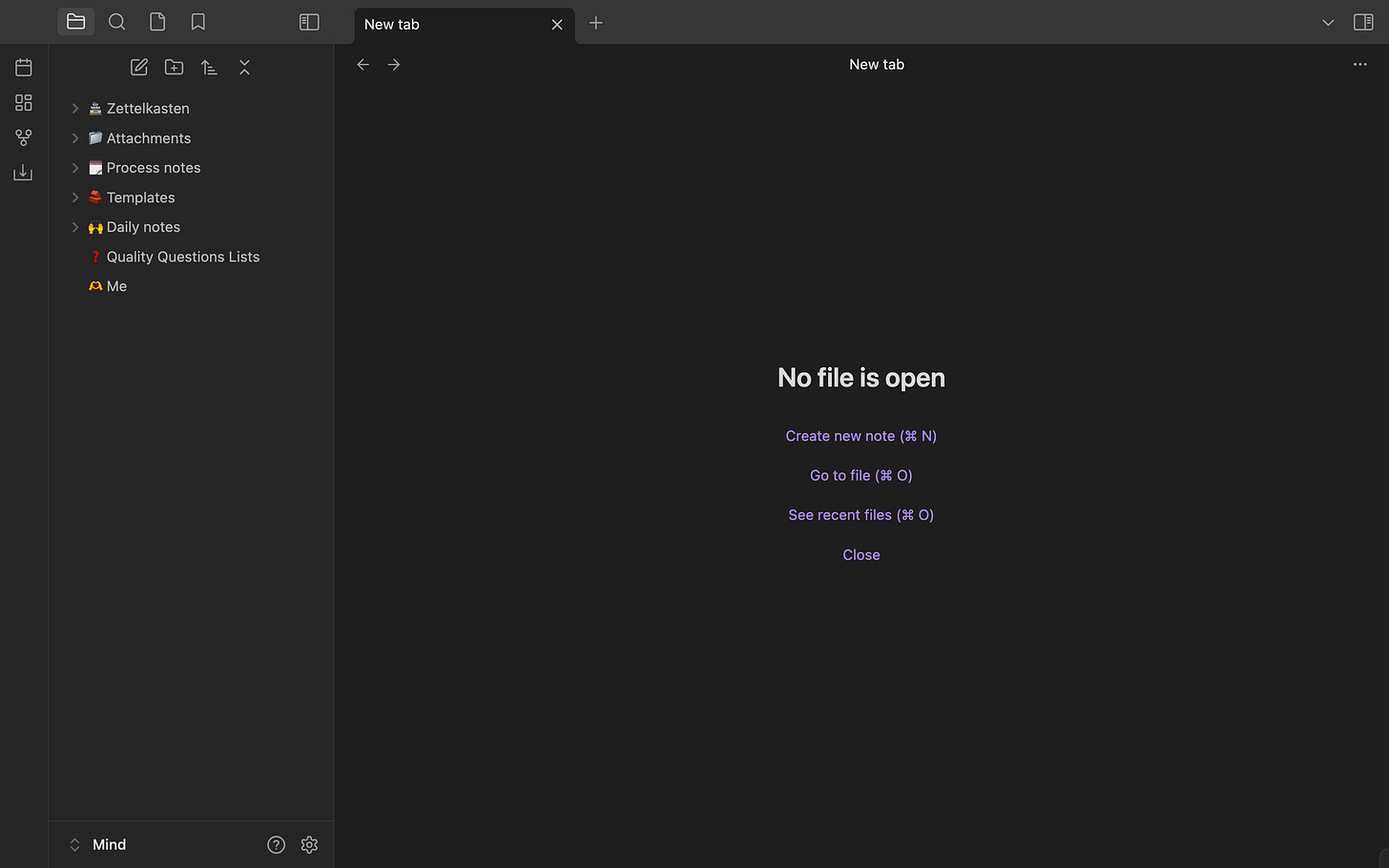
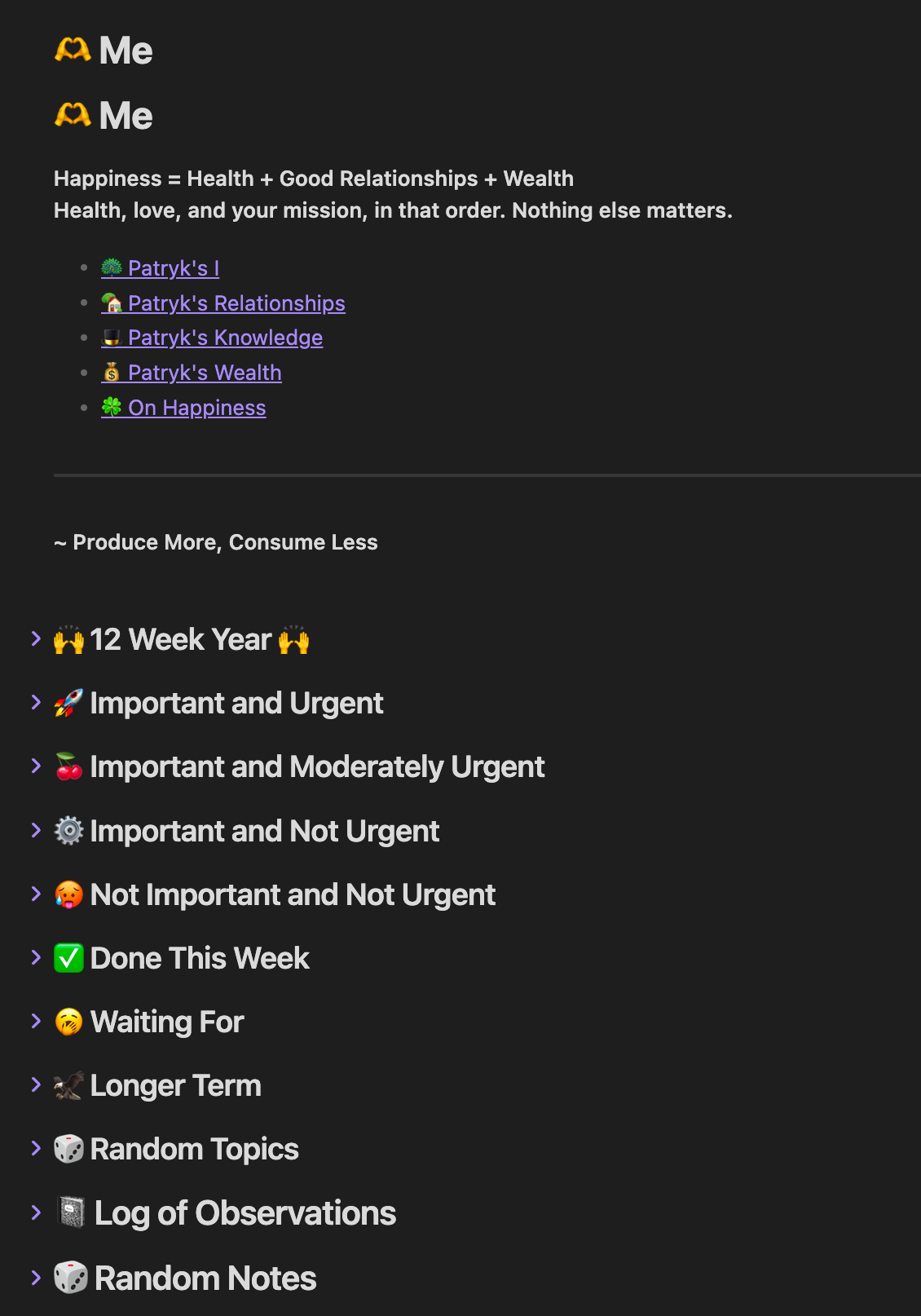
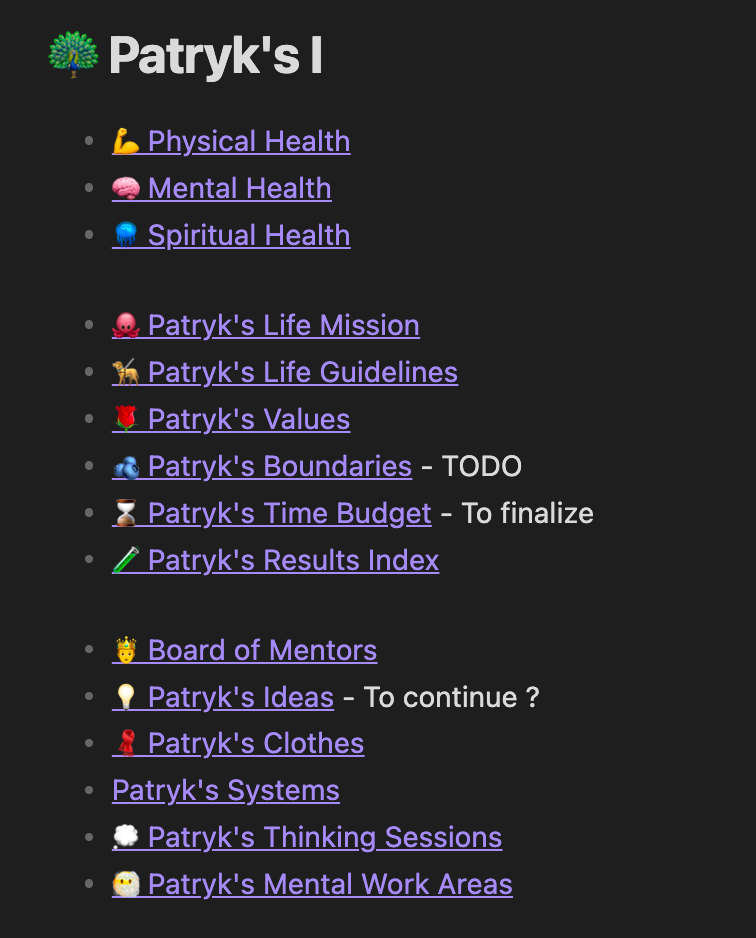
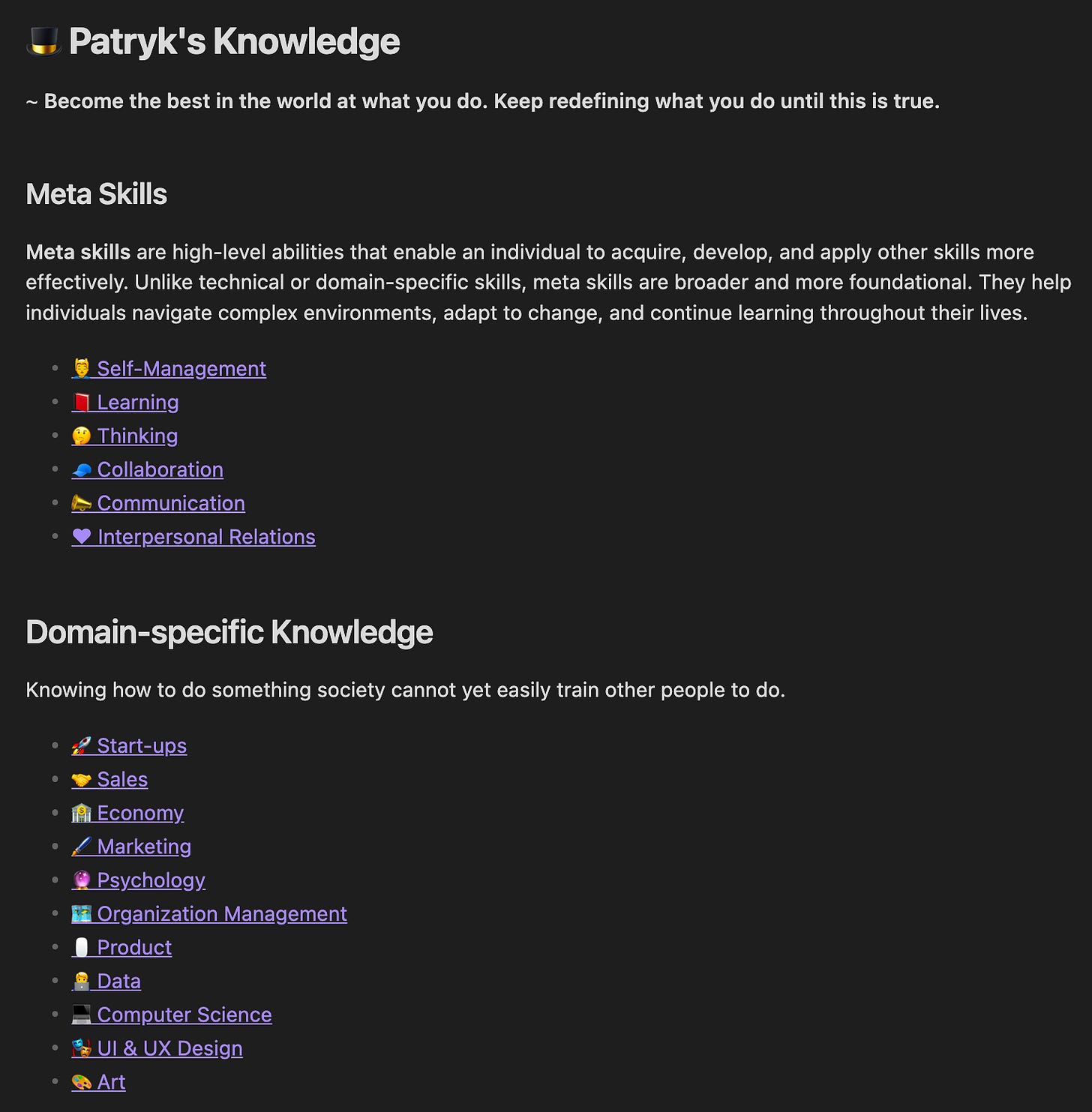
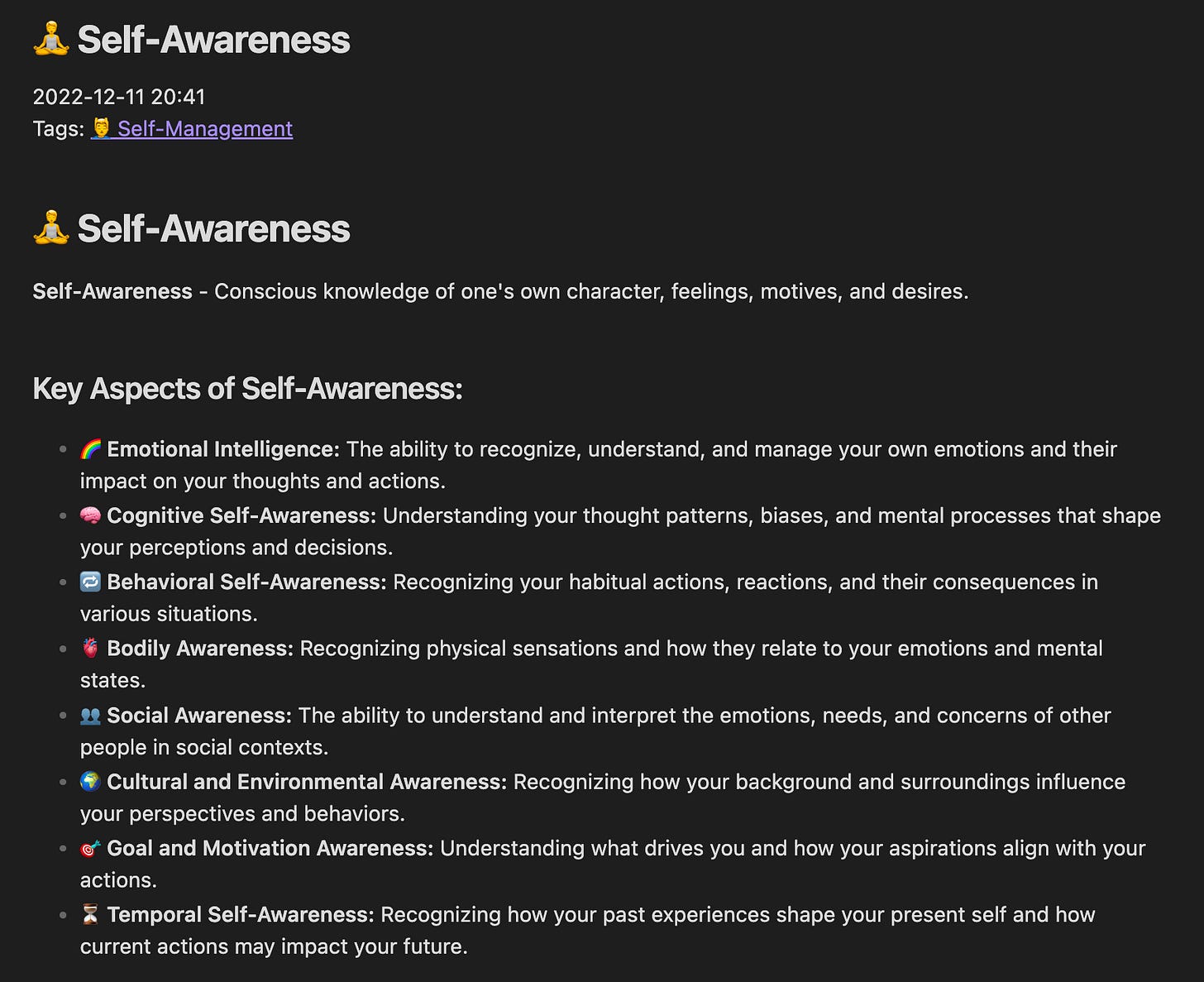
I’ve never seen such a well-organized personal setup before. Must admit, it’s really motivating! I’d used Obsidian briefly in the past as a simple database for PDFs and screenshots, but I had no idea it could be so transformative when applying the right system.
For years, I’ve been collecting notes and quotes in physical notebooks, but it’s never felt efficient. I’ve also tried Notion and Miro for some time, but something always felt missing—they never fully clicked for me. Your approach of reshaping notes to reshape understanding and connecting ideas rather than just filing them away feels like a game-changer. It aligns perfectly with my love of learning and absorbing knowledge for fun while making it actionable and organized.
Small confession here: After reading, I reopened Obsidian and started revisiting old notes—it feels like a whole new discovery journey—ha! The minimalist design and the organic, interconnected system you’ve shared got me going. I can’t wait to experiment and try building a system that reflects my curiosity. Thanks!!!
Patryk, thank you for sharing so much understanding and knowledge. I especially appreciated “This approach reflects a crucial insight: effective personal knowledge systems must balance structure with adaptability.” You’re giving me hope and new tools so that my lifetime learning goal can continue and flourish!